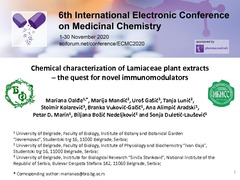Приказ основних података о документу
Chemical characterization of Lamiaceae plant extracts – the quest for novel immunomodulators
| dc.creator | Oalđe, Mariana | |
| dc.creator | Mandić, Marija | |
| dc.creator | Gašić, Uroš | |
| dc.creator | Lunić, Tanja | |
| dc.creator | Kolarević, Stoimir | |
| dc.creator | Vuković-Gačić, Branka | |
| dc.creator | Alimpić Aradski, Ana | |
| dc.creator | Marin, Petar | |
| dc.creator | Božić Nedeljković, Biljana | |
| dc.creator | Duletić-Laušević, Sonja | |
| dc.date.accessioned | 2021-02-03T09:50:46Z | |
| dc.date.available | 2021-02-03T09:50:46Z | |
| dc.date.issued | 2020 | |
| dc.identifier.uri | https://radar.ibiss.bg.ac.rs/handle/123456789/4104 | |
| dc.description.abstract | The physiological imbalance between the production and accumulation of reactive oxygen species (ROS), known as oxidative stress, is responsible for developing and progression of a plethora of diseases – cancer, among others. Since plants are recognized as potential antioxidant agents, the aim of this study was to chemically characterize ethanolic extracts of 18 species from Lamiaceae family using liquid chromatography-mass spectrometry (LC-MS), followed by testing the antioxidant activity using ABTS assay. Biocompatibility of the investigated extracts was assessed by MTT assay on normal human lung fibroblasts (MRC-5). Finally, antiproliferative activity was evaluated using MTT assay on human colorectal cancer (HCT-116) cell line, while the effects of extracts on superoxide anion radical (O2•-) production were tested using NBT assay. Melissa officinalis, Mentha piperita, Origanum majorana, O. vulgare, and Thymus vulgaris showed the highest antioxidant activity against ABTS radicals. LC-MS analysis indicated that these extracts mostly contain caffeic, protocatechuic and p-coumaric acids. The extracts were biocompatible with MRC-5 cell line. Interestingly, Lavandula angustifolia and Ocimum basilicum extracts, which were less active against ABTS radicals, showed a significant antiproliferative effect against HCT-116. Moreover, L. angustifolia and T. vulgaris extracts significantly stimulated the production of O2•- in HCT-116, indicating potential antitumor activity. The extracts that expressed antiproliferative effect and stimulated ROS production contain higher amounts of rosmarinic, caffeic and chlorogenic acids, naringin, luteolin, apigenin and cirsimaritin, indicating that some of them, or more probably their synergistic effects, are responsible for the extracts’ ability to moderate the production of ROS in HCT-116 cells. | sr |
| dc.language.iso | en | sr |
| dc.publisher | Basel: MDPI | sr |
| dc.relation | info:eu-repo/grantAgreement/MESTD/inst-2020/200178/RS// | sr |
| dc.rights | openAccess | sr |
| dc.rights.uri | https://creativecommons.org/licenses/by/4.0/ | |
| dc.source | 6th International Electronic Conference on Medicinal Chemistry: Online; 2020 Nov 1-30 | sr |
| dc.subject | Antioxidant activity | sr |
| dc.subject | Antiproliferative activity | sr |
| dc.subject | Extracts | sr |
| dc.subject | Lamiaceae | sr |
| dc.subject | Phytochemical composition | sr |
| dc.subject | ROS production | sr |
| dc.title | Chemical characterization of Lamiaceae plant extracts – the quest for novel immunomodulators | sr |
| dc.type | conferenceObject | sr |
| dc.rights.license | BY | sr |
| dcterms.abstract | Дулетић-Лаушевић, Соња; Гашић, Урош; Оалђе, Мариана; Мандић, Марија; Лунић, Тања; Коларевић, Стоимир; Вуковић-Гачић, Бранка; Aлимпић Aрадски, Aна; Марин, Петар; Божић Недељковић, Биљана; | |
| dc.rights.holder | © 2021 Sciforum (Basel, Switzerland) | sr |
| dc.description.other | 6th International Electronic Conference on Medicinal Chemistry: session Round Table on Natural Products; 2020 Nov 1-30; Online. Basel: MDPI; 2020. [Available from: https://sciforum.net/paper/view/conference/7280] | sr |
| dc.identifier.doi | 10.3390/ECMC2020-07280 | |
| dc.type.version | publishedVersion | sr |
| dc.identifier.fulltext | https://radar.ibiss.bg.ac.rs/bitstream/id/8120/Oladje-et-al.pdf | |
| dc.citation.rank | M34 |

